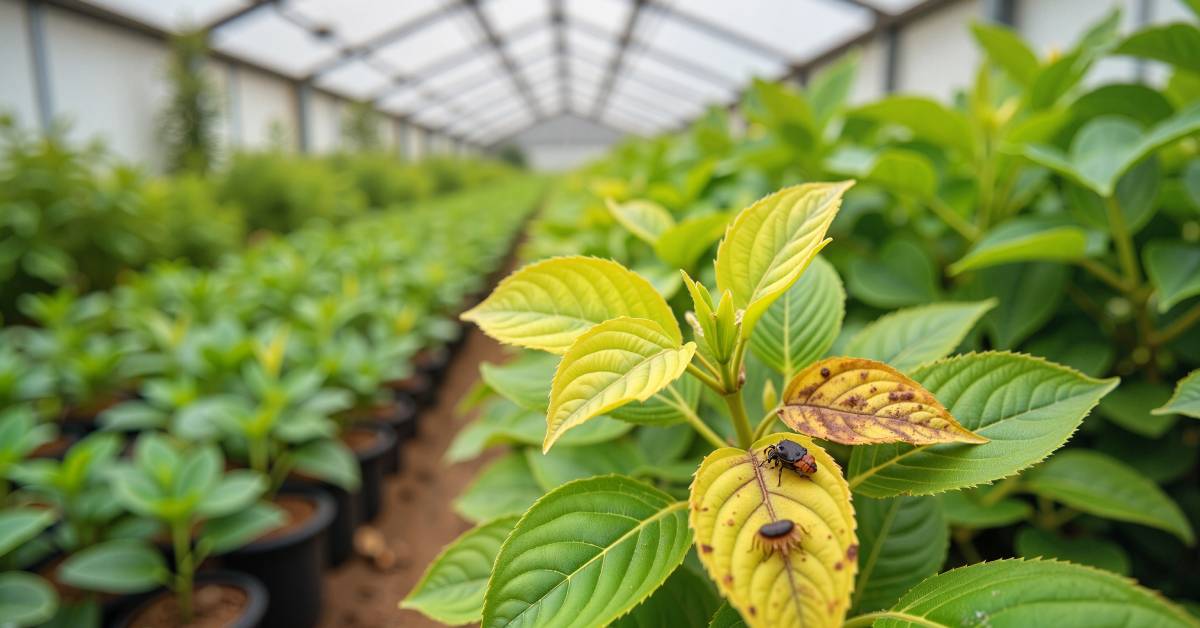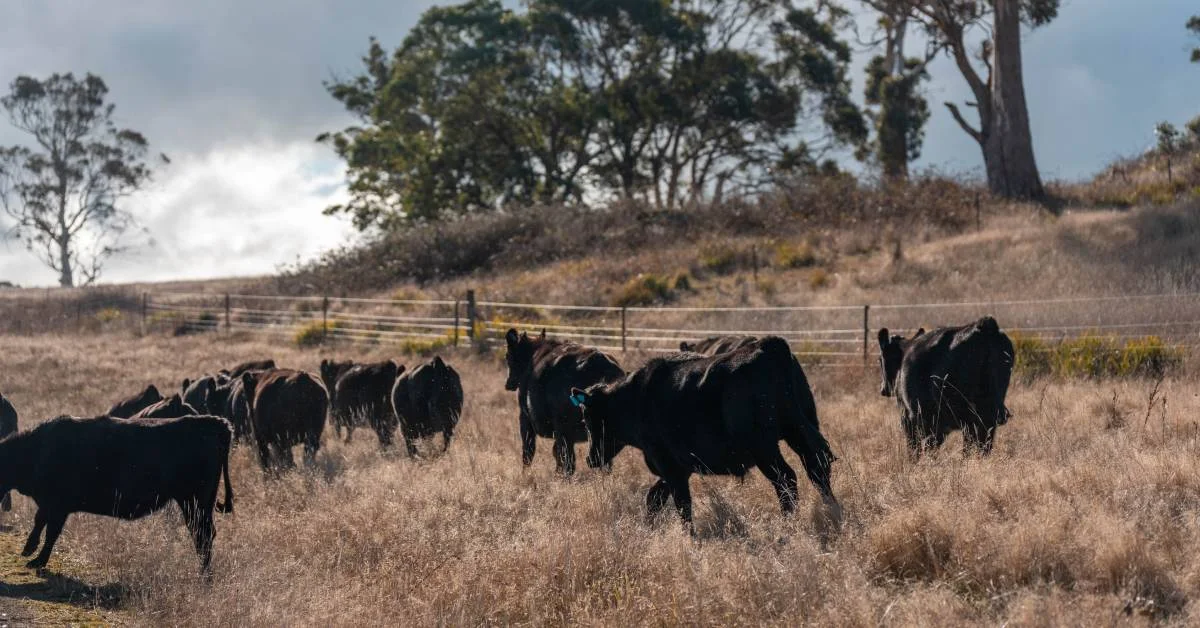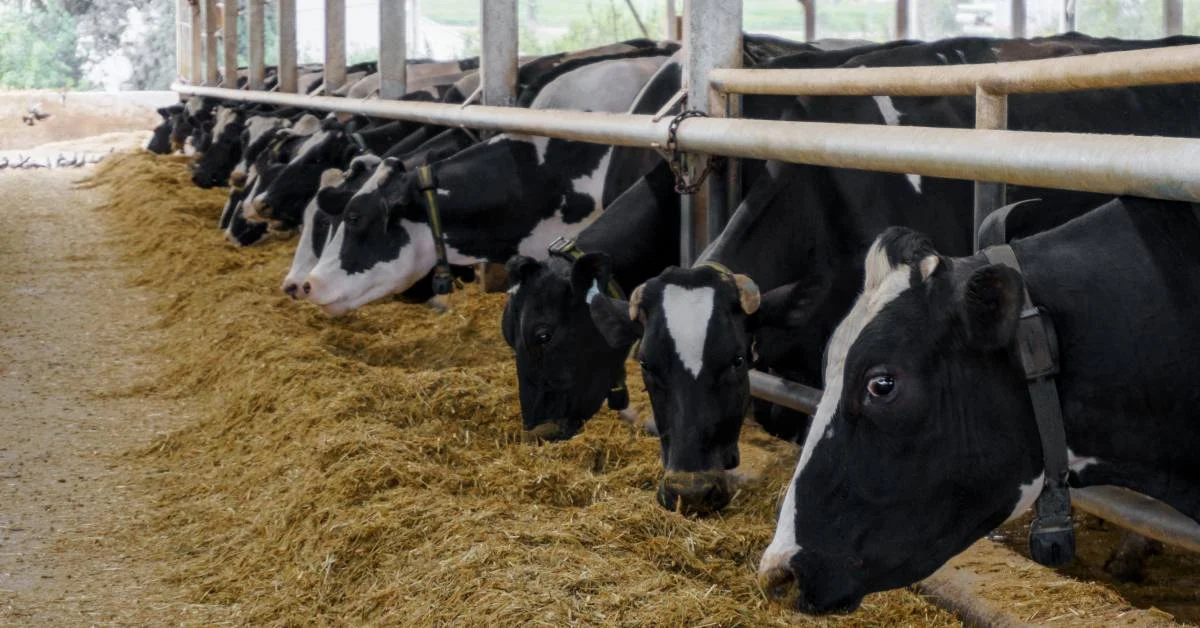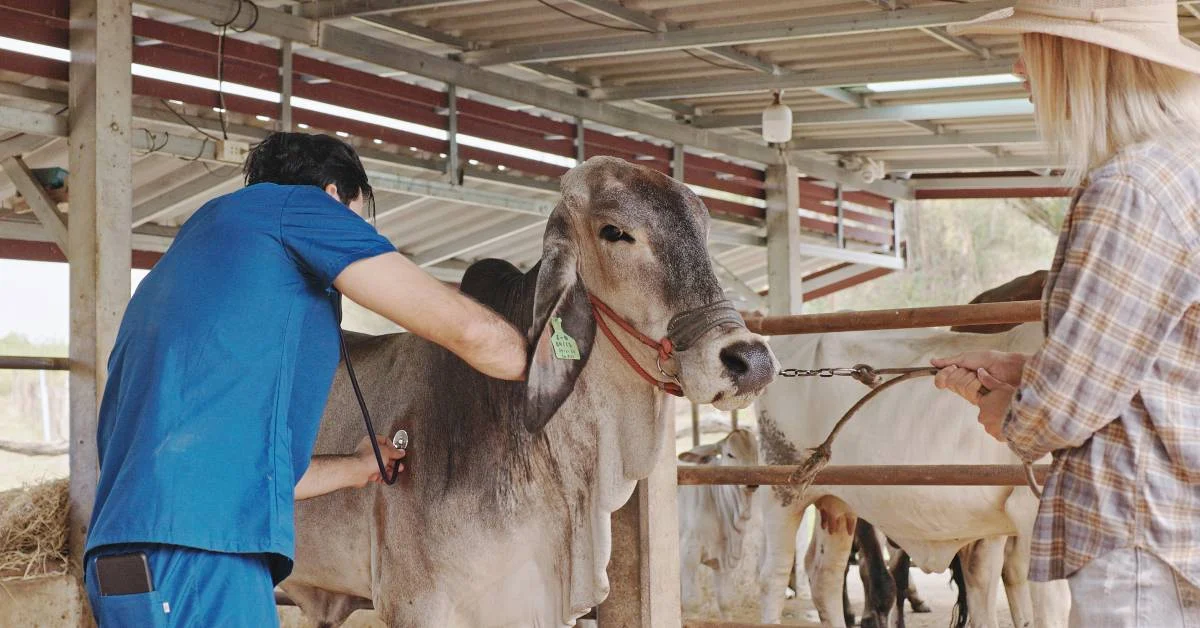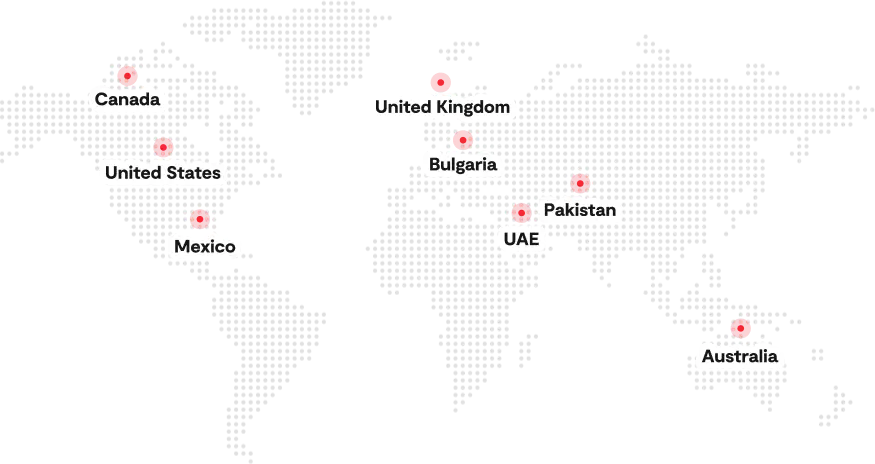Greenhouse farming offers the perfect blend of technology and nature, giving growers precise control over temperature, humidity, and light. But along with these benefits comes a major challenge, which is greenhouse pest control. Unlike open-field systems, where natural predators can limit pest populations, greenhouses create a stable, enclosed environment that allows pests to multiply rapidly. Estimates suggest that 38% of global crop losses are due to insect pests, highlighting how serious the issue can become when infestations are not properly managed. Without effective pest management, even the most advanced greenhouse can see crops damaged, yields reduced, and profitability decline.
Greenhouse pest control refers to the practices and tools used to prevent, identify, and manage pest infestations in controlled environments. These can range from cultural methods like sanitation and crop rotation to advanced digital monitoring and integrated pest management (IPM) systems. Maintaining proper control is essential not just for immediate crop health but also for long-term sustainability and reduced pesticide reliance.
The challenge is that infestations spread faster under greenhouse conditions. Once greenhouse pests such as aphids, whiteflies, or spider mites gain a foothold, they can reproduce at alarming rates due to stable temperatures and the absence of natural enemies. This makes early detection and proactive management a necessity rather than an option.
In this blog, you’ll learn how to identify common greenhouse pests, understand the causes of infestations, and adopt sustainable management strategies. From biological controls to smart digital monitoring, we’ll explore how modern greenhouse pest control can help you protect your crops, reduce chemical use, and ensure healthier, high-yield harvests.
Understanding Greenhouse Pests and Their Impact on Crops
Greenhouse pests are insects, mites, and other small organisms that feed on plants grown in controlled environments. While greenhouses provide ideal growing conditions for crops, they also create a haven for greenhouse bugs to thrive. The consistent warmth, humidity, and absence of natural predators in greenhouse farming make it easier for pests to reproduce and spread quickly. As a result, even a minor infestation can escalate into a serious threat if greenhouse pest control measures are not implemented promptly.
The enclosed structure that protects plants from external threats also traps pests inside, making eradication more difficult. Over time, common greenhouse pests such as aphids, thrips, whiteflies, and spider mites adapt to these stable conditions. Many species have developed resistance to chemical pesticides, forcing growers to rely on integrated approaches that combine biological, cultural, and technological methods of greenhouse pest control.
The impact of these pests extends far beyond visible leaf damage. They can weaken plant growth, reduce photosynthesis, and transmit viral diseases that devastate entire crop cycles. Economically, poor greenhouse pest control can lead to yield losses of up to 30–50% in severe cases, translating into significant revenue declines for growers. The costs of treatment, labor, and recovery further strain profitability.
Key impacts of greenhouse pests include:
- Reduced plant vigor and growth due to sap-sucking and leaf damage.
- Lower photosynthetic efficiency leads to slower crop development.
- Transmission of plant viruses and diseases that spread rapidly in enclosed environments.
- Economic losses and lower profitability from yield reductions and control costs.
Ultimately, understanding the biology and behavior of greenhouse pests is the first step toward effective prevention. With informed monitoring and management, growers can minimize pest-related damage, maintain crop quality, and secure the long-term productivity of their greenhouses.
Identifying Common Greenhouse Pests
Effective greenhouse pest control begins with accurate identification. Knowing which pests are damaging your crops helps farmers choose the right control strategy and prevent repeated outbreaks. Below are some of the common greenhouse pests that pose the biggest threats to greenhouse production, along with their symptoms and management tips.
Aphids
Aphids are among the most common greenhouse pests, thriving in warm, humid environments. They are small, soft-bodied insects that cluster on young leaves, stems, and buds. These pests feed on plant sap, causing yellowing, curling, and stunted growth. In addition, their honeydew secretion encourages mold growth, further damaging crops.
To manage aphids effectively, regular scouting is essential. Introduce biological controls such as ladybugs or lacewings, which naturally prey on aphids. For chemical control, use selective insecticides that target aphids without harming beneficial species. Maintaining proper ventilation and practicing strict sanitation can also reduce infestations and improve overall greenhouse pest control effectiveness.
Whiteflies
Whiteflies are tiny, winged insects that congregate on the undersides of leaves. They are notorious for spreading plant viruses and weakening crops by sucking plant sap. The most vulnerable areas are densely planted zones with poor airflow, where these greenhouse pests thrive.
Early detection is key. Use yellow sticky traps to monitor populations and remove infested leaves before the pest spreads. Biological control options like Encarsia formosa, a parasitic wasp, can be highly effective. Integrating cultural controls, such as pruning and cleaning plant debris, further strengthens greenhouse pest control efforts against whiteflies.
Spider Mites
Spider mites are microscopic pests that thrive in dry, warm conditions, making them one of the most persistent greenhouse bugs. Infestations often appear as fine webbing on leaves and stems. Early symptoms include speckled or discolored foliage, leading to leaf drop and reduced photosynthesis.
Temperature and humidity play a major role in mite outbreaks. Increasing humidity and maintaining consistent watering can help slow their spread. Regularly misting plants and releasing predatory mites like Phytoseiulus persimilis can significantly reduce their numbers. When infestations become severe, use miticides selectively to protect beneficial species while ensuring effective greenhouse pest control.
Thrips
Thrips are slender, winged insects that scrape and feed on plant tissue, causing silver streaks or distorted growth on leaves and flowers. These common greenhouse pests are especially damaging to ornamental and flowering crops, as they can deform blossoms and reduce aesthetic value.
Sticky traps in blue or yellow are effective for early detection. Biological controls such as Orius insidiosus and Amblyseius cucumeris can manage populations naturally. Maintaining consistent sanitation, avoiding over-fertilization, and rotating crops are also critical to minimizing thrip infestations in greenhouse pest control programs.
Fungus Gnats and Shore Flies
Fungus gnats and shore flies are small flying insects that thrive in damp soil or overwatered growing media. While adult flies cause minimal damage, their larvae feed on roots and organic matter, leading to poor plant growth and root rot. Overwatering and organic buildup create ideal conditions for these greenhouse pests.
Cultural control is the first line of defense. Allow the growing media to dry slightly between waterings and improve drainage to limit breeding sites. Beneficial nematodes and predatory mites can also target larvae effectively. Maintaining a clean environment, proper irrigation practices, and well-balanced humidity levels form the foundation of greenhouses and all other kinds of farming pest control methods against these pests.
By identifying and addressing these common greenhouse pests early, growers can protect crop health, reduce pesticide use, and sustain consistent yields year-round.
Causes of Greenhouse Pest Infestations
Even with regular monitoring, greenhouse environments can quickly become ideal breeding grounds for pests when preventive measures are overlooked, resulting in crop failures. Several underlying factors, such as poor hygiene, mismanaged climate conditions, and overcrowded plant spacing, create conditions where infestations thrive. Understanding these causes is crucial for effective greenhouse pest control, as it allows growers to address problems at their root rather than reacting after damage occurs. By maintaining proper sanitation, airflow, and environmental balance, farmers can significantly reduce the presence of common greenhouse pests and safeguard overall crop health. Below are the main causes for greenhouse pest infestations.
Poor Sanitation and Unsterilized Tools
One of the most common reasons infestations start is poor sanitation. When dead leaves, soil debris, or contaminated tools are left unattended, they create ideal breeding grounds for common greenhouse pests like whiteflies, thrips, and fungus gnats. Regular cleaning and tool sterilization are essential parts of effective greenhouse pest control, helping eliminate hidden pest eggs or larvae before they multiply.
Overcrowding and Poor Air Circulation
Dense planting and limited air movement trap humidity, creating a microclimate where greenhouse pests thrive. Overcrowded crops make it difficult to spot early infestations, while stagnant air encourages pest reproduction. Maintaining proper spacing and installing efficient ventilation systems improves airflow and reduces pest pressure.
Climate Mismanagement and Humidity Fluctuations
Inconsistent temperature, light, or moisture levels can stress plants and make them more vulnerable to pests. Many common greenhouse pests thrive in warm, humid, or excessively dry environments. Monitoring and adjusting environmental settings regularly is key to maintaining healthy crops and preventing outbreaks.
Organic Debris and Algae Buildup
When organic matter, such as decomposing leaves or algae accumulates, it becomes a perfect habitat for pest larvae. This buildup often goes unnoticed in corners, under benches, or around irrigation systems. Removing plant waste and keeping the environment clean strengthens your greenhouse pest control strategy and minimizes pest hiding spots.
Greenhouse Pest Control Methods
Effective greenhouse pest control depends on adopting a comprehensive approach that combines prevention, monitoring, and targeted intervention. Since greenhouse pests thrive in stable, enclosed environments, a single strategy rarely works. Farmers need a mix of biological, chemical, and mechanical control methods, supported by consistent management practices. Below are the most effective pest control techniques used in modern controlled environment agriculture setups.
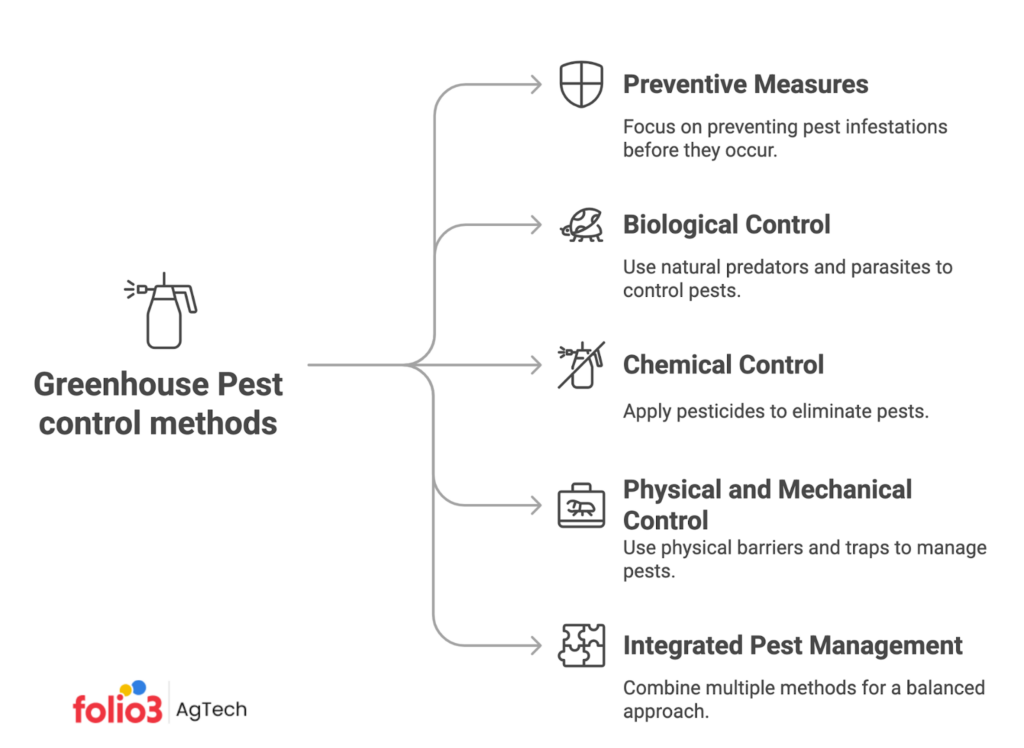
Preventive Measures
Prevention is the first line of defense in greenhouse pest control. Routine inspection of plants helps identify early signs of common greenhouse pests before they spread. New seedlings or plants introduced into the facility should be quarantined and observed for at least two weeks to avoid introducing greenhouse bugs from external sources. Disinfecting equipment, containers, and walkways ensures that pests and pathogens are not carried from one area to another.
Another critical step is soil sterilization, which removes insect larvae and disease-causing organisms before planting begins. Greenhouses equipped with screened ventilation systems can keep flying pests like whiteflies and thrips out without restricting airflow. Regular cleaning schedules and proper waste disposal further reduce breeding grounds for greenhouse pests, maintaining a healthy growing space in both traditional and Hydroponic Greenhouses.
Biological Control
Biological control plays a vital role in sustainable greenhouse pest control, reducing the need for chemical inputs while maintaining ecological balance. Farmers often introduce beneficial insects such as ladybugs, lacewings, and predatory mites, which naturally feed on common greenhouse pests like aphids, thrips, and spider mites. These natural predators are compatible with greenhouse integrations that use sensors or automated systems to monitor pest populations and environmental conditions.
Incorporating biological control fosters a self-regulating ecosystem within the greenhouse. When managed correctly, it helps prevent pest resistance and keeps populations under control year-round. This approach not only supports plant health but also aligns with global trends toward sustainable and environmentally friendly agriculture.
Chemical Control
While preventive and biological methods are preferred, chemical control remains an essential part of greenhouse pest control, especially during severe infestations. The use of targeted pesticides, insecticidal soaps, and horticultural oils can effectively manage greenhouse bugs without causing long-term harm to crops. The key lies in choosing products with low residual toxicity and applying them at precise intervals to prevent pest resistance.
Rotating active ingredients helps maintain effectiveness and minimizes the chance of pests adapting. Safety precautions are equally important; greenhouse workers must wear protective gear and follow label guidelines to avoid exposure. When used judiciously, chemical control complements other management techniques and ensures a balanced, integrated approach to pest reduction in greenhouse pest management programs.
Physical and Mechanical Control
Physical and mechanical strategies offer immediate and chemical-free ways to manage common greenhouse pests. Sticky traps attract flying insects such as whiteflies and fungus gnats, providing both control and monitoring data. Mesh barriers or netting prevent pest entry, while vacuuming equipment can physically remove insects from leaves without damaging plants.
Regularly inspecting and removing infected plants prevents further spread, protecting the rest of the crop. In aeroponic Farming systems, where roots are suspended in air, maintaining clean chambers and precise humidity levels helps reduce pest pressure significantly. These simple yet effective measures play a major role in maintaining long-term pest-free conditions inside greenhouses.
Integrated Pest Management (IPM)
Integrated Pest Management, or IPM, combines biological, physical, and chemical techniques into a single, sustainable framework. This system relies heavily on observation, data-driven decisions, and minimal chemical intervention. By integrating smart monitoring tools and beneficial organisms, farmers can achieve highly effective greenhouse pest control without compromising crop safety or environmental quality.
IPM emphasizes prevention over reaction. It helps identify the exact causes of infestations, from humidity spikes to over-fertilization, and tailors responses accordingly. Over time, this method enhances resilience, lowers costs, and supports long-term productivity in greenhouse pest control systems.
With the right balance of methods, greenhouse operators can transform pest management from a recurring challenge into a predictable, manageable part of modern greenhouse production.
Technology and Data in Greenhouse Pest Control
Modern greenhouse pest control has evolved far beyond manual scouting and reactive spraying. Today, technology plays a key role in early detection and prevention. Tools powered by Artificial Intelligence (AI), Internet of Things (IoT) sensors, and digital imaging systems allow growers to monitor pest activity with precision. These technologies identify pest trends by analyzing temperature, humidity, and light fluctuations that often trigger infestations. AI-powered cameras and smart traps now enable automated detection and capture of common greenhouse pests, while data models analyze pest behavior patterns to predict outbreaks before they occur.
Real-time data collection enables predictive greenhouse pest control, helping farmers act before pests reach damaging levels. IoT sensors integrated into greenhouse systems continuously track environmental conditions and alert growers to potential risks. Drones and smart cameras can even capture images of affected leaves, automatically detecting greenhouse pests such as aphids or spider mites with advanced image recognition algorithms.
Automation further enhances efficiency by reducing human error and dependency on chemical treatments. Automated climate controls adjust temperature and airflow to make the environment less favorable for pest breeding, while robotic sprayers ensure targeted application when intervention is required. As technology becomes more accessible, integrating AI-driven systems and connected devices is transforming greenhouse pest control into a smarter, more sustainable process that protects crops, reduces waste, and improves overall productivity.
Folio3 AgTech: Smart Digital Solutions for Greenhouse Pest Control
Modern greenhouse pest control is becoming smarter and more data-driven with advanced tools like Greenhouse Management Software by Folio3 AgTech now allow growers to predict, monitor, and respond to pest threats more effectively than ever before. At the forefront of this transformation is Folio3 AgTech, a trusted leader in smart farm management and digital pest control solutions.
Folio3 AgTech empowers growers with innovative tools for real-time decision-making, including:
- Integrated pest tracking and alert systems
- Real-time greenhouse climate and soil monitoring
- Data-driven pest prediction analytics
- Mobile dashboards for pest inspection records
By combining technology with practical greenhouse insights, Folio3 AgTech helps farmers control common greenhouse pests, improve operational efficiency, and protect overall productivity. With smarter monitoring and timely responses, growers can achieve stronger yields while maintaining sustainable greenhouse pest control practices.
Conclusion
Effective greenhouse pest control is essential for maintaining healthy crops, stable yields, and long-term profitability. By understanding pest behavior, applying preventive and biological methods, and leveraging technology, growers can manage common greenhouse pests more sustainably. Digital tools like Folio3 AgTech’s Greenhouse Management Software empower farmers with real-time insights and smarter decision-making. Whether you’re managing small-scale greenhouses or advanced hydroponic systems, combining data-driven strategies with good farming practices ensures a pest-free, productive growing environment.
FAQs
What Do Greenhouses Use for Pest Control?
Most growers rely on an integrated approach to greenhouse pest control, combining biological predators, sticky traps, and targeted chemical treatments. These methods help manage common greenhouse pests such as aphids, whiteflies, and thrips without harming the crops or beneficial insects.
How to Keep Bugs Out of Greenhouses?
To prevent greenhouse pests, farmers use insect screens, proper ventilation, and regular sanitation. Maintaining clean tools, sterilizing soil, and monitoring humidity levels also play a key role in reducing the entry and spread of greenhouse bugs inside controlled environments.
What Can We Use to Fumigate My Greenhouse?
Fumigation in greenhouse pest control typically involves using approved sulfur or bio-fumigants to eliminate hidden infestations. However, it’s crucial to follow safety guidelines and only fumigate when the greenhouse is empty to avoid crop damage and ensure worker safety.
What Is the Most Environmentally Friendly Method for Controlling Greenhouse Pests?
The most sustainable way to manage greenhouse pest control is through biological and integrated pest management (IPM). Using beneficial insects, maintaining healthy plant conditions, and adopting digital monitoring tools like those from Folio3 AgTech help reduce chemical dependency while keeping pest populations under control

